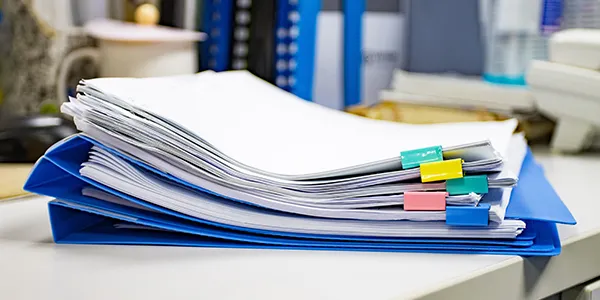
By Elaine Floyd, CFP ®
If you got hit by a bus tomorrow, would your loved ones know how to access your important records? Would they know which accounts you hold and where your money is? What about insurance policies? Real estate ownership papers?
You may have your records organized in a way that works for you, but imagine what your loved ones would face if you weren't around to show them where everything is. This is why an important part of legacy planning is organizing your files so the people closest to you can access them.
1. MAKE ROOM
To start, you'll need a place to put all your papers. Technically, a shoebox qualifies. But to keep your records organized so your loved ones can access what they need, you'll want some kind of filing system. Buy a set of file folders and dedicate a drawer or filing cabinet to hold everything. If you prefer digital records, set up a similar filing system on your computer. Make sure your loved ones know how to get into your computer and have the passwords for your key accounts.
2. GATHER DOCUMENTS
If your documents are scattered in different places, bring them all together in one place.
3. SET UP YOUR FILES
Give each file folder a name corresponding to a category of documents. Examples are:
- Unpaid Bills
- Credit Card Statements
- Receipts for items purchased
- XYZ Bank Account Statements
- ABC Brokerage Account Statements
- IRA Statements
- Life Insurance Policies
- House Records
- Health Records
- Automobile Records
- Tax Returns
Create as many categories as you need. Add subcategories if you wish. For example, if you make substantial improvements to your home, you might keep those receipts in a separate file so you can adjust your cost basis when you sell.
4. DECIDE HOW LONG YOU NEED TO KEEP EACH DOCUMENT
If you've been living without a good filing system, you may be keeping every piece of paper that comes in, for fear you might throw away something important. After doing this for a few (or a lot of) years, you are living with the consequences: too many papers! The day of reckoning is now at hand: Start going through your documents and figure out what you need to keep and what you can (really!) throw away.
Allocate sections of your file drawer to short-term files and long-term files. Short-term files are for the current calendar year and will hold such items as unpaid bills, paid bills, bank statements, credit card statements, and receipts for items purchased during the year. At the end of the year you can toss some of these papers, such as utility statements and receipts for items that: 1) you know you will not be returning to the store; 2) are not tax-deductible; and 3) are not associated with a warranty or major home improvement.
The papers you are keeping, such as bank statements, credit card statements, and receipts for home improvements, will be transferred to your long-term files. This will leave all the short-term file folders empty for bills and statements arriving during the coming year.
Your long-term files should be kept in a fireproof safe or filing cabinet, preferably a portable one that you can grab in case of disaster or emergency.
The following documents will go into your long-term files:
☐ Bank statements (keep for seven years)
☐ Credit card statements (keep for seven years)
☐ Receipts for home improvements (keep as long as you own the home)
☐ Receipts for major purchases (keep for the warranty period)
☐ Operating instructions for major purchases (keep as long as you own the item)
☐ Investment account statements (if year-end statements have all the tax information, these are the only ones you need to keep)
☐ Retirement account statements
☐ House papers: titles, deeds, mortgage documents
☐ Automobile records (keep for as long as you own the car)
☐ Insurance policies (keep current ones; toss the ones no longer in force)
☐ Estate planning documents (will, trust, power of attorney, health care directive, prepaid burial papers)
☐ Copies of tax returns
Also in a section of your long-term files, to be kept indefinitely, will be your vital documents. These include:
☐ Passports
☐ Birth certificates
☐ Marriage certificates
☐ Divorce decrees
☐ Social Security cards
☐ Military records
5. FILE YOUR DOCUMENTS
Once your folders are all set up, it will be simple matter of putting each document where it belongs. If you encounter a document that doesn't quite fit in any of your existing categories, create a new file folder. Keep doing this as much as you need to. It doesn't hurt to have too many folders, especially if it will help your loved ones better understand what you have.
6. STAY ON TOP OF IT
Once you have a manageable system in place, it will be easy to stay on top of it. When a bill comes in, put it in the Unpaid Bills folder. After you pay your bills, put the statements in the appropriate Bills Paid folder. When bank and investment account statements come in, put them in the appropriate folder.
At the end of the year, empty the short-term folders. Pull out the documents you'll need for tax filing and set them aside. Transfer account statements to the long-term section, along with receipts for major purchases and other items that may have landed in the short-term section but that you want to keep. Receipts and statements that have outlived their purpose (i.e., are not needed for taxes) can be thrown away.
An up-to-date, well-organized filing system is a gift to yourself. No longer will you have to search for a particular document when you need it because everything will be immediately at hand. It is also a gift to your loved ones, who will be grateful to have quick and easy access to your records if the need ever arises.
Elaine Floyd, CFP® is Director of Retirement and Life Planning for Horsesmouth, LLC, where she helps people understand the practical and technical aspects of retirement income planning.
Insurance products and services are offered through Buska Retirement Solutions, Inc. Tax services are offered through Legacy Tax Solutions, LLC, an affiliated company. Buska Retirement Solutions, Inc. is not affiliated with or endorsed by the Social Security Administration, the federal Medicare program, or any other government agency. Buska Retirement Solutions, Inc. does not offer tax planning or legal services but may provide references to tax servicesor any other government agency. Buska Retirement Solutions, Inc. does not offer tax planning or legal services but may provide references to tax services or legal providers. You should always consult with a qualified professional before making any tax or legal decisions or legal providers. You should always consult with a qualified professional before making any tax or legal decisions.

